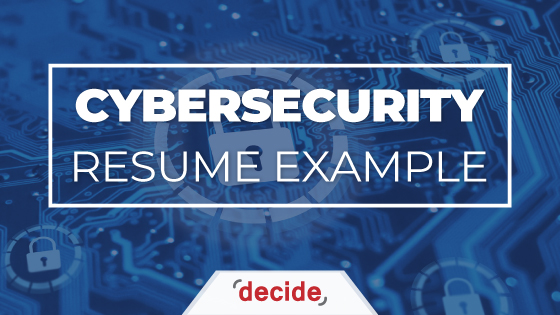What makes a good resume for a cybersecurity professional? We have seen thousands of resumes come to our recruiting team. We have sent thousands of resumes to our clients. There are some best practices and we have put our best examples together in this resume example for a cybersecurity professional.
Keep in mind this is a resume example for experienced cybersecurity professionals. If you are a new graduate, a software developer, a senior executive, or not in IT, not all these best practices apply.
Key Principles
- For technical people, skills are currency. Put them in early and often.
- Certifications matter more to Infrastructure and Cybersecurity than other IT roles.
- Forget the one-page resume. Very few IT people have a one-page resume. It is not expected.
- Redo Page One. Instead of the one-page resume, focus on putting your most valuable information to an employer in the top half of page one. The second most valuable information in the bottom half of page one.
- Page one should mention your most recent employment or project.
- Do not make the resume reader guess what you are best at. Make it easy and clear for them to know.
- Resume objectives are optional. For the experienced cybersecurity professional, your skills and certifications are the greatest currency and speak to what you do. If you have been a cybersecurity professional for five years and the resume is full of skills that support that, the employer knows you are looking for a cybersecurity job. If you are looking for something different, then a resume objective makes sense to have.
The Heading
Put the basic contact information here. No need for the full address. City and State are fine. You can always out the full address at the bottom. Your street address does not help sell you to the employer. Do include your LinkedIn URL. The employer will most likely want to see this before talking to you. If you have a premium certification, mention it here.
Summary Section
Include 4-6 bullet points of what you do best and what you know best. This sets the tone with the reader about what you specialize in. As a technical professional, this is a chance to point out the skills you excel at. Avoid the temptation to lengthen this to 10+ lines. We often see resumes that stretch the summary to 40+ bullet points that go well into page 2. It loses effectiveness.
Skills Section
Skills are currency to technical people. A good exercise for any IT person to do before starting their resume is to take a skills inventory. Think through past projects and pieces of training. What things did you use? What third-party tools or packages were part of your work? Cybersecurity people tend to use more tools than software developers. Every time we ask a cybersecurity professional to do this exercise, they always wind up adding it to their list. This does not mean you should add every piece of technology you have ever worked with. It does make you think about the most relevant ones.
Break these skills into groups and list them out. What you have worked with the most or know best, list those first. Again, this is a way to communicate to the employer what you specialize in. If they are looking for someone who knows the intricacies of SIEM solutions and you have that mentioned three times on page one, they have confidence you are a match and probably want to talk with you.
Do not list skills in alphabetical order. It leaves the reader guessing what you know best. It may lead them to think you know Mac OS better than Windows if that is not the case.
Education, Certifications, and Training
We often debate whether to put this on page one or the last page. The answer goes back to the guiding principles – if this sells you to employers then include it on page one. Otherwise, put it on the last page.
If you went to a nationally regarded top 25 school or a big regional school in your area, it makes sense to put it on page one. If you are applying to jobs in San Diego and you have a degree from Harrisburg University, think about putting your education on the last page.
Cybersecurity job descriptions require certifications more than other IT jobs. It is a good idea to list your premium certifications on page one.
The Work Experience
Finally, we get to the work experience. It is best to summarize the last 2-3 years of your work on page one. 8-12 bullet points for every 3 years is best. For many people, this aligns well with their job history.
If you have worked at a company for 8-12 years, you need to break it out differently. The technology you worked with 12 years ago is hopefully different than what you have done in the last year. You can break it out by projects, job titles, or company phases.
In this Cybersecurity Professional Resume Example, we want to help experienced Cybersecurity professionals put their best foot forward. A good resume gets you that interview. That interview gets you that new job and probably more money. It is worth your time to use our resume example and spend some time thinking through how to present yourself best. Here is the full WORD version of this sample resume.
Read More: Is COVID Changing the Job Market for Software Developers?
Read More: Why is Python the Top Choice for Data Scientists
Read More: What Soft Skills to put on a Technical Resume Part 2
Read More: What Soft Skills to put on a Technical Resume Part 1
Are you finding it harder to locate the good technical and IT talent? Many companies find them selves in the same situation. There are some better ways to locate and attract the right it and technical people to your company. Contact us to learn more.






